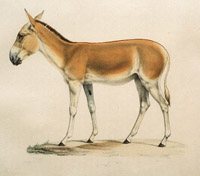
Erforschung biologischer Ressourcen der Mongolei / Exploration into the Biological Resources of Mongolia, ISSN 0440-1298
Date of this Version
2007
Document Type
Article
Citation
Erforschung biologischer Ressourcen der Mongolei (2010) band 10: 9-28.
Results of the Mongolian-German Biological Expeditions since 1962, No. 281.
Abstract
Inspired by studies on biodiversity in the South Gobi we were confronted with the human impact on animal communities and endangered animal species, especially the Asiatic wild ass. So the idea was born to organize an international conference with the aim to actualize the status of Equus hemionus in Central Asia and to find ways for better conservation of this species and its habitats. A short review is given on historical exploration, decreasing area and population number of the Dschiggetai. Today the range of the nominate form of Equus hemionus is located in the Gobi region of southern Mongolia/northern China only. Therefore international engagement is necessary to save this indicator species of the arid zone of Central Asia.
Included in
Asian Studies Commons, Biodiversity Commons, Desert Ecology Commons, Environmental Sciences Commons, Nature and Society Relations Commons, Other Animal Sciences Commons, Population Biology Commons, Terrestrial and Aquatic Ecology Commons, Zoology Commons


Comments
Copyright 2007, Martin-Luther-Universität Halle Wittenberg, Halle (Saale). Used by permission.